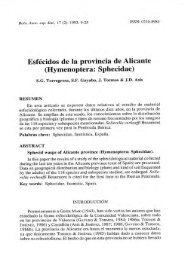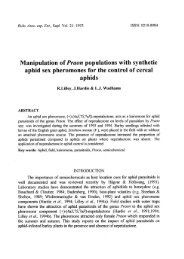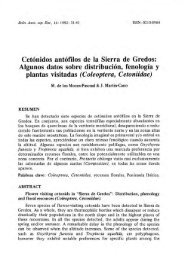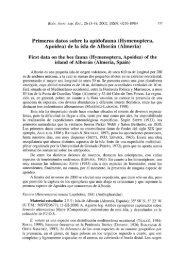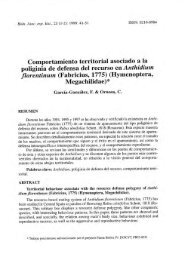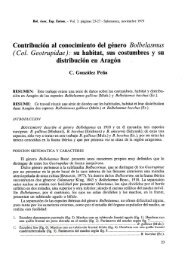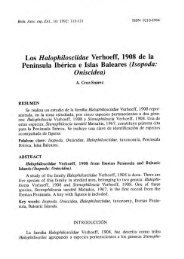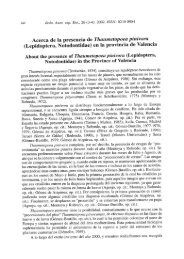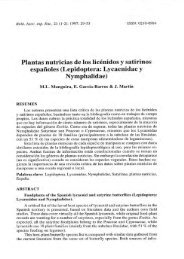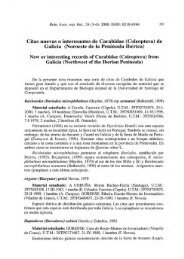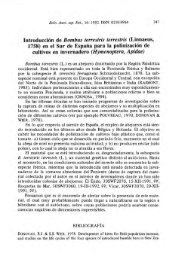Libro 1.indb
Libro 1.indb
Libro 1.indb
You also want an ePaper? Increase the reach of your titles
YUMPU automatically turns print PDFs into web optimized ePapers that Google loves.
GALL MIDGES (DIPTERA: CECIDOMYIIDAE) OF THE IBERIAN PENINSULA 131<br />
territory into six frequency groups, viz. the species occurring very scarcely,<br />
scarcely, medium frequently, frequently, very frequently and most frequently.<br />
These terms expressing the frequency are used also in paragraphs of each<br />
species in the Annotated list. These frequency data has been referred to<br />
the actual knowledge. Nevertheless, future studies could change this actual<br />
frequency but the present knowledge is presented here. Mayetiola destructor,<br />
a widely distributed pest of cereals, is not included in the following<br />
evaluation.<br />
In the Iberian Peninsula 115 species (44%) occur very scarcely. Each<br />
of them was recorded in the Iberian Peninsula at only one locality. Some<br />
of these species were described by Tavares and other researchers and subsequently<br />
they have not been found anywhere, as for example, Blastodiplosis<br />
thalictricina, Contarinia camphorosmae, Dasineura bragancae and some<br />
of other species described by Tavares; Baldratia suaedae, Stefaniola gloma<br />
and S. vastita by Möhn; Dasineura erodiicola and Dasineura mariae by<br />
Sylvén; Etsuhoa thuriferae by Skuhravá; Aprionus wildeni and Peromyia<br />
suberis described by Jaschhof. Many species that occur abundantly in<br />
Central Europe reach in Iberian Peninsula the southern boundary of their<br />
distribution, as for example Putoniella pruni causing galls on leaves of<br />
Prunus spinosa (Fig. 104). Dasineura oleae causing galls on leaves of Olea<br />
europaea, which is very abundant and is considered to be a pest in central<br />
and eastern Mediterranean, was found at only one locality in the Iberian<br />
Peninsula (Fig. 48).<br />
Eighty seven species (33%) occur scarcely. Each of them has been found<br />
at 2, 3 or 4 localities. Mikiola fagi causing galls on leaves of Fagus sylvatica<br />
was recorded at four localities in north-eastern part of Spain (Fig. 94). It<br />
is the representative of European fauna. It occurs abundantly in Central<br />
Europe and reaches in north-eastern Spain the most southern limits of its<br />
distribution area. Nevertheless, we have to mention that this species attacks<br />
leaves of Fagus sylvatica and, although this host tree is only restricted in<br />
some areas of north and the northest parts of the Iberian Peninsula, M. fagi<br />
is very abundant in these areas. On the other side, Baldratia salicorniae<br />
causing galls on Arthrocnemum fruticosum is a Mediterranean species which<br />
was found at four localities situated along the seaside of the Mediterranean<br />
Sea and of Atlantic Ocean (Fig. 16).<br />
Thirty four species (13%) occur medium frequently. Each of them has<br />
been found at 5, 6, 7 or 8 localities. Of these species, the most interesting<br />
is Stefaniola salsolae causing rosette-like galls on buds of Salsola vermiculata<br />
was found at 5 localities (Fig. 122); Dasineura asparagi causing galls<br />
at tips of young shoots of Asparagus aphyllus was found at 5 localities<br />
(Fig. 34) and D. broteri causing cone-shaped galls on buds of Erica ciliaris<br />
Boln. Asoc. esp. Ent., 30 (1-2): 93-159, 2006



